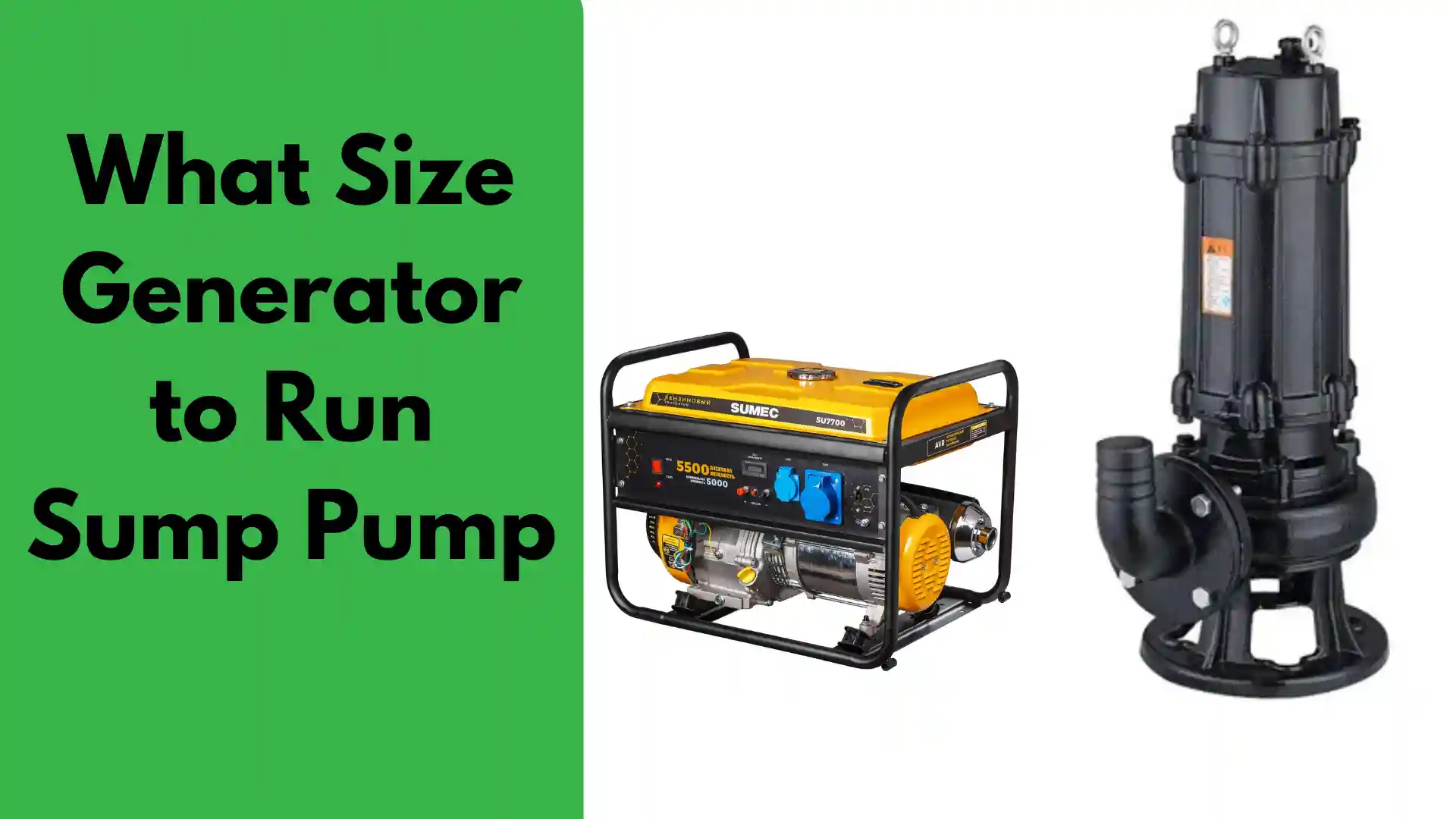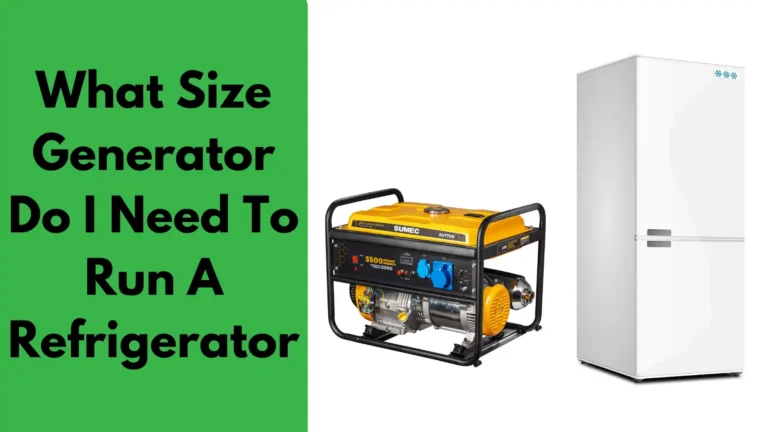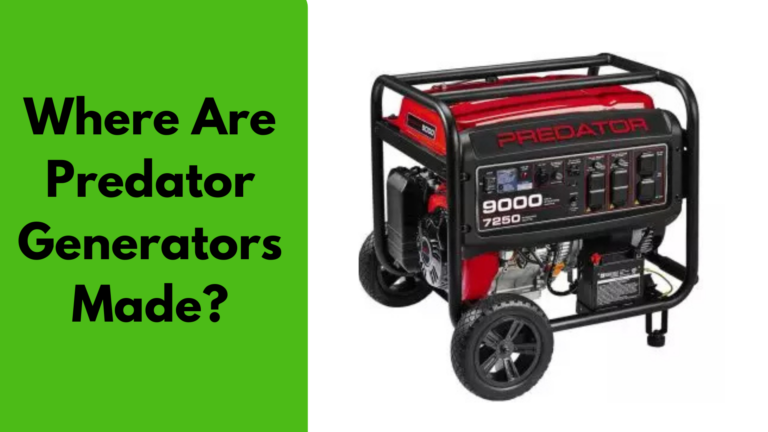What Size Generator to Run Sump Pump?

When it comes to preparing for emergencies, one of the most important devices to consider is a backup generator.
Specifically, if you live in an area prone to heavy rainfall, flooding, or power outages, you may rely on a sump pump to keep your basement or crawl space dry.
But have you considered how much power a generator needs to run a sump pump effectively? Selecting the right size generator can ensure your sump pump operates efficiently during a power failure, preventing costly damage to your home.
In this comprehensive guide, we will walk you through the process of choosing the right generator size for your sump pump, discussing the key factors you need to consider to make an informed decision.
To run a sump pump, you’ll need a generator with at least 2,000 watts capacity, as most sump pumps require 800-1,500 watts running power but have a higher starting surge of 1,300-2,150 watts; however, to ensure reliable operation during emergencies and allow for additional essential devices, a 3,000-4,000 watt generator is recommended, especially for larger sump pumps or if you have a backup pump system.
Why You Need a Generator for Your Sump Pump
A sump pump is essential in preventing basement flooding by removing excess water that accumulates around your home’s foundation.
During a power outage, however, your sump pump will stop working unless it is connected to a reliable power source. In such cases, a generator serves as a critical backup solution, allowing your sump pump to continue operating even when the grid is down.
However, not all generators are suitable for powering a sump pump. It’s essential to choose one that is properly sized for the job.
A generator that is too small may not be able to handle the power demands of the sump pump, while a generator that is too large may waste fuel and add unnecessary cost.
What Size Generator Do You Need to Run a Sump Pump?
Here’s what you should consider before buying a generator for your sump pump:
Power Ratings (Starting and Running Watts):
Like all electrical devices, a sump pump has both starting and running wattages. You need to know these before choosing a generator.
You can find the wattage information on the energy label (usually yellow) of the sump pump, which shows details like frequency, amps, voltage, and horsepower. You can also check the user manual or use a device like a multimeter to measure the exact wattage and amps your sump pump uses.
For example:
I have a sump pump that uses 120 volts, with 10 running amps and 15 starting amps. To calculate the wattage, use this formula:
Watt = Amp x Volt
- Running Watts = 10 amps x 120 volts = 1200 watts
- Starting Watts = 15 amps x 120 volts = 1800 watts
So, based on this example, a 2000-watt generator would be enough for the sump pump. You should add 10-20% more wattage to account for power losses.
The Number of Sump Pumps You Plan to Use:
If you have more than one sump pump, you need to calculate the wattage/amps for each pump and add them together to get the total wattage you need.
Will You Use Other Appliances?
If you plan to run other appliances (like a refrigerator, air conditioner, or microwave) at the same time as the sump pump, you need to add the wattage of each appliance and choose a generator that can handle the total wattage.
We also have a detailed guide on choosing the right generator size for a house with multiple appliances.
Are You Using an Older Sump Pump?
Older sump pump models use more power compared to newer ones. Newer models are more energy-efficient, with technologies like LVS (Low Voltage Series) or inverter technology, which helps save on electricity costs.
Why Do You Need a Generator for Your Sump Pump?
During a power outage, your sump pump may stop working, which can lead to flooding in your basement. To avoid this, it’s a good idea to have a generator to keep your sump pump running.
For example, during a power outage, I use a 4000-watt generator to power my sump pump, and it runs for about 8 hours on a single 3-gallon tank of fuel.
Key Factors to Consider When Choosing a Generator for Your Sump Pump
Several factors must be considered when determining the appropriate generator size for your sump pump:
1. Power Requirements of Your Sump Pump
The first step in selecting a generator is understanding the power consumption of your sump pump. Sump pumps generally require two types of power to operate:
- Running Wattage: This is the amount of power the sump pump needs to run continuously.
- Surge Wattage (Starting Wattage): This is the extra power required to start the pump. Sump pumps often draw more power at startup than while they are running.
It’s crucial to account for both of these values when choosing a generator. The surge wattage is especially important since the generator must be able to handle the initial spike in power demand when the pump starts.
2. Sump Pump Size and Power Rating
Sump pumps vary in size, and their power needs depend on the type and horsepower of the pump. Typical residential sump pumps range from 1/4 HP (horsepower) to 1 HP, with most homes using a 1/2 HP or 1/3 HP pump.
Here is a general guide to help you determine the wattage requirements based on the pump size:
- 1/4 HP Sump Pump: Requires around 600-700 running watts and 1,000-1,200 surge watts.
- 1/3 HP Sump Pump: Requires about 800-1,000 running watts and 1,200-1,500 surge watts.
- 1/2 HP Sump Pump: Requires roughly 1,000-1,200 running watts and 1,500-2,000 surge watts.
- 3/4 HP Sump Pump: Needs about 1,500-1,800 running watts and 2,200-2,500 surge watts.
- 1 HP Sump Pump: Requires approximately 2,000-2,400 running watts and 2,800-3,000 surge watts.
How Many Amps/wattages Does a Sump Pump Use?
| Sizes | Wattages | Amps |
|---|---|---|
| 1 hp Sump Pump | 2,000 | 10 |
| ½ hp Sump Pump | 1000-1050 | 6 |
| ¾ hp Sump Pump | 1,500 | 8 |
| ¼ hp Sump Pump | 550-600 | 3.5-3.8 |
| 1/3 hp Sump Pump | 800 – 900 | 3. 8 – 4 |
To ensure you select the right generator, check the manufacturer’s specifications for your sump pump model to find the exact wattage requirements.
Example Generator Sizes for Common Sump Pump Models
| Sump Pump Size | Running Watts | Surge Watts | Recommended Generator Size |
|---|---|---|---|
| 1/4 HP | 600-700 | 1,000-1,200 | 1,000-1,200 Watts |
| 1/3 HP | 800-1,000 | 1,200-1,500 | 1,200-1,500 Watts |
| 1/2 HP | 1,000-1,200 | 1,500-2,000 | 1,500-2,000 Watts |
| 3/4 HP | 1,500-1,800 | 2,200-2,500 | 2,500-3,000 Watts |
| 1 HP | 2,000-2,400 | 2,800-3,000 | 3,000-3,500 Watts |
3. Type of Generator: Portable vs. Standby
There are two main types of generators to consider for running a sump pump:
- Portable Generators: These generators are commonly used for backup power during emergencies. They are more affordable but require manual setup and refueling. Portable generators typically provide a wide range of wattage options, making them versatile for powering sump pumps of various sizes.
- Standby Generators: These generators are permanently installed and automatically turn on when there is a power failure. They are more expensive than portable generators but provide the convenience of automatic operation. Standby generators are typically powered by natural gas or propane, which means you don’t need to worry about refueling.
The type of generator you choose depends on your preferences and budget, but both types can effectively power your sump pump if properly sized.
4. Fuel Efficiency and Run Time
Fuel efficiency is an important consideration when selecting a generator for your sump pump. During extended power outages, you will need a generator that can run for hours without frequent refueling. A generator with a larger fuel tank or one that runs on natural gas or propane is typically more fuel-efficient, reducing the need for frequent stops to refill the tank.
When considering run time, it’s also important to take into account how long your sump pump typically runs during a storm. For example, if your sump pump runs frequently during heavy rainfall, you’ll need a generator with enough fuel capacity to run the pump for several hours.
5. Generator Wattage Capacity
The key to selecting the right generator size is ensuring it can handle the running and surge wattage requirements of your sump pump. Based on the power consumption of your sump pump, choose a generator with a slightly higher wattage capacity to ensure it operates effectively without being overloaded.
For example, if your 1/3 HP sump pump requires 1,000 running watts and 1,500 surge watts, you would want to choose a generator with a minimum capacity of 1,500 running watts and at least 2,000 surge watts.
6. Additional Appliances and Devices
In some cases, you may want to run other essential devices, such as lights, refrigerators, or other appliances, during a power outage. If this is the case, you need to account for the wattage of those devices as well. Add up the wattage of all devices you wish to power simultaneously and choose a generator with enough capacity to handle the combined load.
Conclusion
Selecting the right generator to power your sump pump is crucial for ensuring your home remains safe during power outages.
By understanding the wattage requirements of your sump pump and considering factors such as the type of generator, fuel efficiency, and additional appliances, you can choose the right generator size to meet your needs.
A properly sized generator will ensure that your sump pump continues to operate even when the power goes out, protecting your home from the damaging effects of flooding.

I’m Alan William’s, the founder of SmartHeatSolution.com. I am from California, USA, I’m passionate about innovative heating technologies and their impact on our homes and businesses. With a background in electrican and home repair , I aim to make smart, energy-efficient heating accessible to everyone. When I’m not writing, I’m likely interested in all the thermostat brands and their new technnology. Thanks for stopping by!

![How to Bypass Co Sensor on Generator? [6 Step Guide] 4 How to Bypass Co Sensor on Generator](https://smartheatsolution.com/wp-content/uploads/2024/12/tinywow_Business-33_71905886-768x432.webp)

